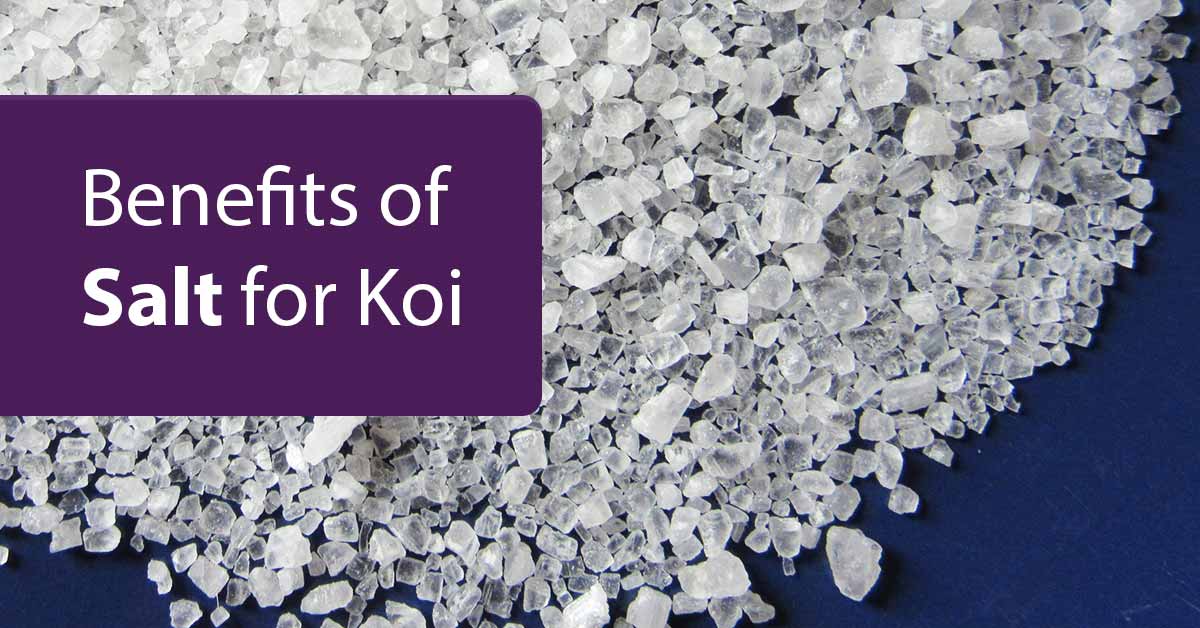
My name is Taro Kodama and when I first started working for my Koi Master father more than 20 years ago, one of the things that surprised me, was that we used salt so much. I mean A LOT of salt!
Some of you may have had a similar experience as mine in your koi research and wondered, “Is salt actually good for a koi pond?” or “Can I just use table salt (Morton salt) in my pond?”.
To help our koi hobbyists have the healthiest pond for koi, I would like to discuss proper salt usage in this article.
Table of Contents – Salt in Koi Pond
- Is Salt Good for a Koi Pond?
- Why Do We Use Salt?
- How Do You Use Salt for Koi?
- What Type of Salt for Koi Pond?
- How Much Salt Do I Use in Koi Pond?
- How Do I Check Salt Level in My Koi Pond?
- Will Adding Salt Kill Pond Plants?
- How Can I Measure Pond Volume Using Salt?
Watch Video – Benefits of Salt in Koi Pond
Is Salt Good for a Koi Pond?
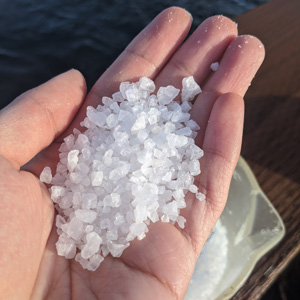 Yes, it has many benefits for creating a defense against bacteria and parasites.
Yes, it has many benefits for creating a defense against bacteria and parasites.
When used correctly, it effectively treats new, stressed, or sick koi in your pond. If you want to use salt in your pond, then read through this article very carefully and ensure you understand how it is used before adding to your pond.
Too much salt is toxic and can even kill your koi, so be careful when you say “It is good for koi”. Salt is good for defending against bacteria; but in fact, it is actually harmful if used too much.
Why Do We Use Salt, Non-iodized salt, Sodium Chloride (NaCl)?
Salt will help to treat parasites, fight nitrite toxicity, and improve mucous slime coat production with an inexpensive solution that will fit in with your biological filter. Learn more about winter pond prep and survival in our blog post.
There are 2 main reasons why we use salt for Koi, both are about maintaining a healthier fish:
1. Use salt to take care of parasites and/or bacteria on a Koi’s body. Koi live in freshwater. So do parasites and bacteria. A koi pond salt treatment helps eliminate freshwater parasites and bacteria. I personally feel that parasites are becoming more resistant and that salt hardly kills parasites, but it still works well for something like columnaris bacteria.
2. Use salt to promote sickness recovery by balancing a Koi’s osmoregulation. To explain, a Koi is a freshwater fish; but because the salt level of its body fluid is much higher than the surrounding water, water keeps coming into its body. Its body does not burst because it can release water as urine and thus stay balanced. When a Koi gets sick or stressed, that affects its body’s function of balancing osmotic pressure. To help remedy this, we can add salt to raise the koi pond salt level to closely match that of a Koi’s body fluid. This way the water does not enter its body as much. The benefit is that the Koi’s body does not have to work as hard which helps the Koi recover quicker.
An extra advantage of salt is that it is not a medicine. So we don’t have to worry about any side effects.
What koi issues can salt help with? According to Dr. Erik Johnson, an author of “Koi Health and Disease: Salt at 0.3% is credited with the clearance of the following:
- Chilodinella (24-
36 hours) - Epistylis (24 hours irregardless of temp)
- Ichthyophthirius (72 hours at tropical temperatures)
- Costiasis (Ichthyobodo necatrix)
- Trichophrya (24 hours irregardless of temp)
- Glossatella (24 hours irregardless of temp), (24 hours regardless of temp)
- External Tetrahymena
- Almost every single Trichodiniid/Tripartiella organism.
- Inhibits trematode reproduction, clears 30% of adults.
- Inhibits Lerneiid reproduction
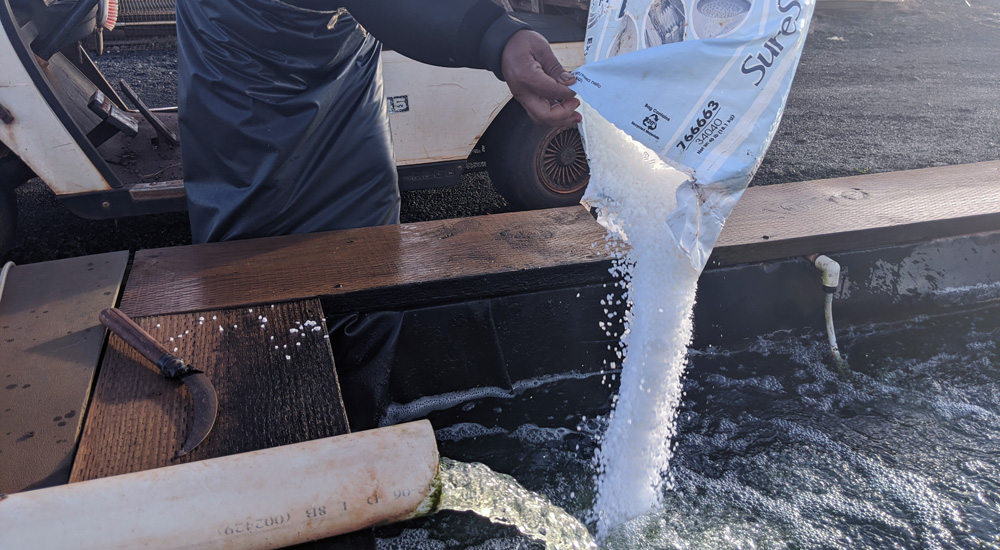
How Do You Use Salt for Koi Health?
Now that you know why salt is used, the next question is, “Should I put salt in my koi pond?”
There are 2 scenarios when we use salt:
- When your Koi swim awkwardly or are obviously sick.
- When you buy a new Koi and bring it to your home.
In both situations, it is highly recommended to treat the Koi in a quarantine tank with salt.
Before you add salt, remember to remove plants, clean the pond, and perform a 50% water change if you have time to delay the salt treatment.
In the winter and fall, some say that using pond salt will help survival during the cold winter months, but we do not agree and believe you should only use salt when it is needed. If you have a pond heater, then that will be enough to keep koi functioning through the winter. Always use salt in a quarantine tank or temporary tank to increase fish’s natural resistance to disease.
You may consider letting the salt dissolve in a bucket of pond water before you add directly in the pond, to keep it from burning koi with an area that is too concentrated or not yet dissolved.
Leave in the water and add in gradually. It may take 14–21 days to completely remove parasites, varying under different temperatures. Add the salt all at once if your fish are dying rapidly.
Remove salt with partial water changes. Don’t pour out the excess water onto a tree or plant since it could do some damage.
What Type of Salt for Koi Pond Salt Treatment?
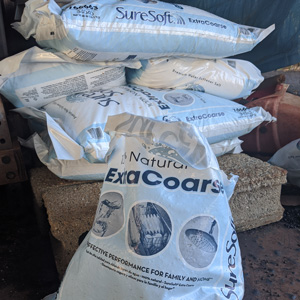 Use non-iodized pure salt. You can buy a big bag of salt at a hardware store like Home Depot or Lowes.
Use non-iodized pure salt. You can buy a big bag of salt at a hardware store like Home Depot or Lowes.
Please never use salt with formalin. Salt and formalin do not get along. If you use salt and formalin together, it could kill your Koi. Regarding what kind of salt to use in your koi pond, avoid table salt and any iodized salt.
Salt is toxic to Koi if used at high levels for longer periods of time. If using too much, it will shut down their kidneys, and one of the reasons many people have Koi with “pop-eye” or symptoms like Dropsy.
How Much Salt Do I Use In Koi Pond?
The dosage varies from 0.3%–0.6% salt level for treating illness.
Otherwise for consistent use, 1 kg (2.2 lb) of salt per every 1000 liters (265 gallons) of water, which makes approximately a 0.1% salt water solution.
I recommend you start with 0.3% and gradually raise it to 0.5% as needed. 0.6% is recommended only when your Koi seems to be very stressed or sick. Read more about helping sick koi in this blog article.
Spread out your salt treatment throughout a few days and continue monitoring the salinity levels. You DO NOT want to use too much salt for the safety of your koi, too much can be deadly!
Remember that salt does not evaporate; and when doing a water change, add your salt based on amount of the water replaced, not the total volume of pond.
Quick Salt Bath Option for Koi Rescue
(Be Careful!) – There is another way to use salt. It is a quick salt bath. You dissolve as much salt as possible in a bowl of water. Then, you move the Koi to the bowl and leave it there in the highly concentrated salt water for a short time.
This is mainly to kill any parasites or bacteria on the surface of the body. The Koi will start floating, and you will see a white layer developing on the body. Then you rescue the Koi from the bowl and release it to your pond. However, it could kill Koi if done incorrectly. So I will recommend this method only if you are with a professional dealer.
How Do I Check Salt Level in My Koi Pond?
Use a digital salt meter. Please never guess your pond’s salt level. I had an accident once before at my farm.
One experienced staff member had added a regular amount of salt in one of the tanks. But soon after, Koi started dying. At first, we did not know why; but found out later that there was some salt left in the tank from a previous use. She had not checked the salinity. She simply assumed that all the salt content was gone and added another regular dosage of salt. That addition increased the salinity much higher than the Koi could handle; and they died.
So please check your salt level every time before adding salt to your pond.
We Recommend a Digital Salt Meter for Better Accuracy
A digital salt meter for koi will be far more accurate than a drop salt test kit. Use this digital salt meter before and after salt is added.
Remember, salt is toxic to your koi and you do NOT want to add more than the recommended, or you will risk losing your koi.
About Koi Medic Salt Meter ($99) – The meter is very accurate and easy to use, simply turn it on and dip into the pond. Within two seconds, the LCD will display the salt concentration measured in “percentage”.
Operating Range : 0.00 to 1.00%
Accuracy: +/- 0.03%
Battery Life: 150 hours
Will Adding Salt Kill Pond Plants?
If you have water plants, you are definitely now wondering, “Will salt kill my pond plants?” The answer is that many pond plants cannot take as much salt as your Koi. So if you are unsure if the plants can take salt or not, remove pond plants before you add salt to your koi pond. For this reason, I usually recommend you avoid growing water plants in Koi ponds.
As salinity level increases, these pond plants become less able to tolerate and are sensitive to salt:
- anacharis
- water hyacinths
- lotus
- lavender musk
- water lilies
- forget-me-nots
- zebra rush
- cattails
- floating hearts
Even with the ability to remove and control blanket weeds or algae, it is risky to use salt treatments with your pond plants.
How Can I Measure Pond Volume Using Salt?
We can also measure pond volume using salt. Surprisingly most Koi hobbyists and pond owners do not know their ponds’ volume. Here is a way to use salt to get a more exact amount of water volume.
Some owners may have the information; but a lot of times, it is simply a rough estimate. One time a client of mine believed he had a 10,000 gallon pond, but we found out that it was only 3,000 gallons. That really scared me because what if we had used medicine or salt based on the wrong information? It could have destroyed the whole population of his pond.
If we use a salt concentration equation, it is pretty easy to calculate your pond’s exact water volume. Here are the steps:
- Check the salt level of your pond with digital salt meter
- Add 1 lb of salt or any appropriate pounds of salt
- Recheck the salt level, ensuring that all salt is completely dissolved
- From the difference of the salt level’s new percentage, calculate the total water volume as follows:
If you use liters for pond volume, the formula is KG / % = VL.
- KG = kg of salt added
- % = actual concentration change in %
- VL = Volume in liters
For example, you estimate that your pond holds about 10,000 liters (approximately 2,650 gallons).
- You check the salt level. From a previous use of salt, the reading shows 0.1%
- To increase another 0.1% in 10,000 liters pond, you must add 10 kg (approximately 22 lb) of salt. So you add 10 kg of it to your pond
- After the salt completely dissolves, the reading now shows 0.18%
- So 10 kg of salt increased the salt levels by 0.08% (= 0.18% − 0.1%). 10 / 0.08% = 12500. This means your pond holds 12,500 liters (approximately 3,300 gallons)
- P = pounds of salt added
- % = actual concentration change in %
- VG = Volume in gallons
Join Kodama Koi Newsletter
Get insider knowledge and sign up for our Kodama Koi newsletter to receive a free koi varieties poster! New subscribers will also receive a 10% off coupon for kodamakoisupply.com when joining.
The Major Benefits of Salt For Your Koi Pond
Salt does a fantastic job to handle bacteria and parasites on a koi’s body. It also balances osmotic pressure when a koi is sick or stressed to help the koi better recover.
The use of salt vs. medicine means you do not have to worry about side effects. Working with a dealer, you can create a salt bath of highly concentrated salt water solution and put koi in for a short time to quickly kill surface bacteria.
Be careful. Since salt is toxic to koi, do not rush into using salt as a remedy in your koi pond. If your koi are swimming awkwardly or look sick or you buy a new koi, it is recommended you treat the koi in a quarantine tank with salt. This will also keep you from using too much salt in the main pond and risking loss of your full koi stock.
Comment below with any questions and good luck with your future pond management.
Enjoy related reading from our blog:
- Diagnose Sick Koi Symptoms and Treatments
- Setup Your Koi Quarantine Tank
- How to Care for Koi Fish
- Koi Fish History / Nishikigoi Meaning
- The Best Koi Food Guide
- Understanding Different Koi Pond Filters
- Biological Pond Filter for Koi
- Winter Pond Prep and Survival Guide
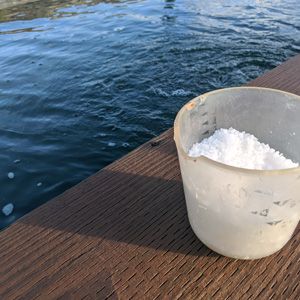

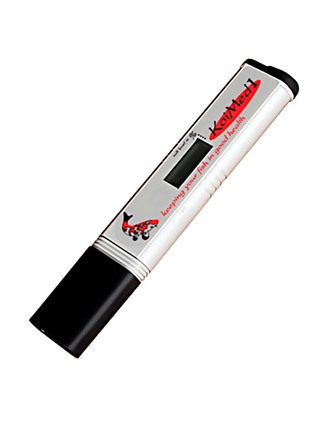
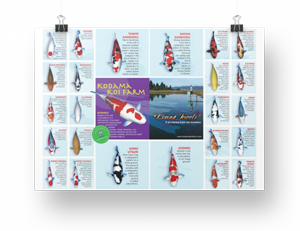

Love it! Thanks Taro
Hi Carolyn, Sanke You!
Hello I have a 3000 gallon pond. I had a ph spike and the fish had bloody tails flashing and jumping. I pulled a few out and their gills looked normal but they were majorly stressed. I had a pond guy tell me to rise the salt from 1% to 2%. He left me his salt gauge and told me at .20 to keep adding salt.. I was at .40 this morning and they were acting better this afternoon.. the pond guy called and told me to keep adding more but reading your article im afaid to. Please help I have some koi ive had for years and I couldn’t stand losing them.. pond currently at .40
My apology for the late reply. The max we usually use at the farm is 0.6%. So 0.4 is OK.
Hi dear
All my koi is good health
One question I need always use salt 0,3% in water for normal koi good health or no need to add salt (0,3% )
Best regards
Hi, my koi had a red spots on the body, how cure this?
Hello,
Please send our team an email at info@kodamakoifarm.com so that we can help properly diagnose your koi to most efficiently help you.
Good morning. Hopefully you can help me understand my tds meter it’ is in parts per million on the reader showing 1515 . I’m not sure watt that is? To high/ low have some bacterial infection going on
Many thanks Rodders
Hi 1500 gallons pond how much rock salt should I use thanks
Hi
You should use 3 pounds per 100 gallons,
Use 5 pounds of salt.
Regards
Customer service team
Hi i have a 1000 gallon koi pond whats a safe salt ppm reading on my TDS meter fir consistent use please.
Very well written, accurate and solid advice for a novice or professional. Thank you!
Thank you
Hi Toro
I just started building a pond.i’m very interested in koi fish.can you give me some advise
Thank you
I use concentrated salt bath for sick fish. Sometimes they actually curl up and stop breathing altogether. Before putting back in the pond I revive with a hose through mouth and gills. Never lost one yet and amazing results like new fish within hours.
How long can you keep a koi quarantined in .3% salinity before it’s harmful?
Thanks
It will not harm the koi keeping the salinity at .3% The koi will accumulate to the environment.
Would epson salt work?
I am sorry I do not know what epson salt is
Please… never use salt with formalin…and…no iodized salt at all.
Can I give my kio a salt bath in the winter months as I have noticed that one of my kio has some sores on its side scales, and if so what are the simplest ways to do this.
Please could you reply asap
Thanks
Rob
You may, but when water is cold, Koi’s immune system does not work well. If you can, please keep her in a separate holding tank with warmer water. That should help her heal better and quicker.
no Epsom salt ! It will kill the koi , it is a metallic salt magnesium sulfate , totally different than sea salt !
Good Morning Taro,
I live in a cool summer climate. The water temperature drops to 46F during the winter and reaches 64F in summer. Will my koi grow at these temperatures?
Hello, your Koi grow but maybe not as fast and big as other warm area. For proper diet, please find the feeding guide at https://www.kodamakoigarden.com/koi-food-guide/
Hi Gary,
My wife and I have a 5500L pond with 20 koi, marginal plants and aquatic plants.
We live in Edmonton, Alberta, Canada and our winters go well below -40C ( -45F to -45-F).
Our fish winterize in the pond all winter for 4-5 month. We cover our pond with a frame of 2×4 and 1″ foam insulation.
We use a floating cattle heater that keeps the water at 0-5 C and maintain 1 pump running for under water flow.
No waterfall in the winter. It cools the water too fast.
Come spring, we uncover the pond and the fish are fine.
They actually grow in size during the winter. We don’t even bother feeding them during the winter months. The eat from the plants, and detrital matter in the pond.
The plants grow with the fish and it isnt uncommon to have green growth in the middle of winter.
Koi’s are carps and they are very sturdy fish. I call them the golden retriever of fish …
On a different note…some owners have released koi’s and gold fish in the wild and they are actually a problem. We live in a VERY cold continental climate and these fish have no problem surviving. In fact, they thrive !
Truth is we had a 7 degtee unexpected temperature for 4 days.. it was way below freezing.
We luve in Texas where 2 degrees below freezing only last 1 day…every 3rd year.
I was amazed….Not one koi died.
I am glad you did not lose any.
Hello Taro,
This is a wonderful article. I have learn a lot after reading this. Thank you so much for sharing a valuable experiences. Do you mind if I send you an email in case I have a questions about Koi, water and treatments, etc.?
Hello, I am glad you found this article useful. Of course. we are always happy to help. You can email us at sales@kodamakoi.com
hi just treated pool with 25kg of salt reading at start was 0.02 after treatment treating 0.32 .How many litres or gallons of water are in my pool please would be good to know ,any help would be appreciated thanks eamonn
Hello, so it increased by 0.3% by adding 25kg salt. Correct? If so, it will be 8333 litters.
Doesn’t adding tap water with a high salt content (my tap water is higher than .1ppt) due to pond evaporation increase the salinity of a pond? And if so, what do I do about it?
If your source water has salt in it, there is nothing you can do. If it is not going too high, that is OK. With regular weekly change of water, I am sure the salinity will stay low.
Hello Taro,
Was searching for dosage info & glad I saw ur link. I’m in CA, so winters are mild in comparison. If Koi health is not an issue, is it ok to maintain .1% level for overall health year round? If yes, will invest in digital salt meter & make certain salt is dissolved.
Hello, Thank you for your comment. If your Koi is healthy, I do not see any need for another action there. Enjoy your Koi
Good Morning Taro. Thank you for this very helpful article, and for answering questions from your readers! My husband and I recently moved our three koi to a newly built 850 gallon above ground pond in the north Georgia mountains. Because the nitrogen cycle had not been established (we had no clue!) they began flashing, sitting on the bottom and not eating. We began daily 50 percent changes for a week and have been doing 25 to 30 percent daily water changes for a couple of months. We also reduced the amount of food we give them by more than 50 percent. These steps lowered the ammonia and made the fish feel better (current ammonia levels are about .25 ppm. We About two weeks ago we finally registered nitrites, with current levels between 2 and 5 ppm. Two of our koi are now eating vigorously and seem to be doing well. Two of them are now eating vigorously again, but our largest koi (she is about 16 inches) is not eating, which worries us because she is usually the most aggressive eater. Would adding salt help relieve her stress? We are worried it might interrupt the development of beneficial bacteria. If this is true and we can’t add salt, is there anything else we can do? Thank you so much for any advice you can share!
Sorry for the late reply. I would need more information. Please contact our office at info@kodamakoifarm.com. Hopefully your concern is solved by now
Please help I am building a 1500 gallon pond. How much salt will I be using? Do I keep that amount for the life of the pond?
No sir. In my opinion, you need salt only when you need it. For the detail, please read the above.
Will salt help lower Nitrites ? If so do you know how quickly it will help. Thank you for the article!
I am sorry I do not know
Will the salt water from my pond hurt my plumeria when we clean the barrels and release a lot of the water into the garden?
Thank you.
Aloha Dave. Salt water is ok, Plumeria have high water retention and do well with acidic water.
I think you need to check your gallon formula for volume calculation of pond based on salinity change. I think the ( ) is incorrectly placed. The gallon conversion does not equate to 3300 ( example used) if calculating inside ( ) first then the rest of formula. Believe simple removing the ( ) results in the correct answer. Also, would simplify by just combing the last two valves to just 12 (10 x 1.2).
Hi, Thank you for your feedback. I am sorry I am not really good at math. So can you explain again?
22 / (0.08% * 10)*1.2= 3300
=22/0.008 x 1.2
=2750 x 1.2
=3300
This is how I did the math.
Hi, Thank you for your feedback. I am sorry I am not really good at math. So can you explain again?
22 / (0.08% * 10)*1.2= 3300
=22/0.008 x 1.2
=2750 x 1.2
=3300
This is how I did the math.
Hi Taro, I think I found the problem with the formula.
.08 * 10 = .8
.08 / 10 = .008
my meter is in ppm and says 685 so what is the percentage im a new pond owner and i find your website is very helpful. thank you
I assume it is 0.0685%. How much salt did you put to what gallons of water? Thank you very much for reading our blog.
Hi after reading the comments from various keepers I’m stunned to hear I’m not doing the right things at all ,I’ll explain I have koi gold fish couple of tench , pond is 6000 ltr I have water fall 2x 15000ltr fish mate filters uv , oblong pond no plants no heater , been this way for good 10yrs , one else had a bad bout of losses for no apparent reason ,and twice had ulcers , some dropsy in gold fish , now I have used malakite green ,and have used pond salt ,at a rate of one teaspoon per one ounce like now I’ve done this reading various books from keepers and trades , now reading some statements here I’m wondering how my fish have survived so long ? I would like to hear yours and your readers views thanks , John .
Hi, one of my koi in the pond started having ulcers after a pond water change and filter cleaning. Another fish also grew a mass at the end of it fin and the lump started growing. The aquarium store told me it’s the bacteria that caused it. He recommended maracyn and maracyn two. I treated my koi and the gold fish but they don’t seem to work. Now the ulcer for the koi started developing at his tail. The don’t seem to appear sick as they eat and swim fine. Please help. What can I do?
Without seeing them in person, it is hard to make any suggestions. It may be the best to find your local vet to ask for the help. Or please use anti-biotics (I am sorry I do not know the products you mentioned). https://www.kodamakoifarm.com/koi-sick-health-diagnosis-symptoms-diseases/
https://www.kodamakoifarm.com/how-to-make-medicated-koi-food/
I think these information should help you.
Hello, I just got two 4 inch kois for my 55-gallon tank. I bought them both online. They both seem like they have parasites. They would do sudden rapid movements out of nowhere and would rub on the walls of the tank. I have tried every parasite treatment possible except for PP and salt. How much salt should I put into my 55-gallon tank or in my 5-gallon bowl for a salt bath?
Many parasites are resistant to salt, so I am not sure if it will solve the problem. Maybe you can try with 3lb/100 gallons. So for 55 gallons, 1.5lb would work.
Does salt inhibit the cycling of a pond and slow conversion of nitrites to nitrates?
Suggestion – purchase rock salt from places like The Bulk Barn. It’s pure, no additives and 1/3 rd the price ($1.10 per lb.) that pond outlets and Amazon dealers charge.
Trying to figure my pond volume out in gallons. I used one pound of salt and my tds went from 22 ppm to 140ppm over the next 3 days. Can you tell me the math please. Excellent site! Thanks for sharing your knowledge.
Hi Taro, I’m having trouble with the math for volume of water. I added 1 pound of salt to my pond and the meter I have showed the salt jump up from 22 ppm to 140 ppm. Thank you in advance for your help. Your site has and shares it’s knowledge. Thank you again
Hello, I am not really good at ppm. Can your salt meter read the level by %
PPM is parts per million, percent is parts per hundred (cent is Latin for 100 – per cent); so just divide ppm by 10,000 to get percent.
How long after the final dose of Terminate can you start adding salt to the pond? The pond currently doesnt have any salt in it.
I did this Salt thing for my New Koi pond and I think it’s really promoting good aquatic health! I’m researching heavily on stuff like this since I’m still a newbie on pond maintenance! I just had my pond construction along with the pond kits near me here by last week. I hope I can pull it off and really make the Koi and the pond itself flourish!
Good morning. Hopefully you can help me understand my tds meter it’ is in parts per million on the reader showing 1515 . I’m not sure watt that is? To high/ low have some bacterial infection going on
Many thanks Rodders
1515 ppm can be easily converted to percentage as follows:
(1515/1,000,000) x 100 = 0.1515%
I’m using the digital salt measure, just like the picture above on this page and the reading for my 3000 litre pond says 134 ppm – how do I convert this to a % that people are referring to in the above comments. What is an ideal ppm or % please. Pond is 22.5 degrees.
Does Salt help a Koi with “Koi Pox” ?? Mine has dull white wax like nubs on her pectoral fins. A grey tone on her body. Salt level is now at .30
Thinking of building a larger koi pond in the same area. Will it be okay to put my koi in our salt water swimming pool while it is being built?
As long as the salinity is 0.5% or below, and there is no chlorine, it should be fine
I’m confused about using salt for maintenance purposes. We were first told to use it regularly by a professional, but this only resulted in harming or killing our koi, so we stopped. We then were told to treat the pond only in the fall before the koi went to sleep to protect them in winter. So last year we used MicrobeLift Broad Spectrum treatment which contains formalin. Now we are told it doesn’t help with most diseases, that salt is better, and that we should use .1% before the fish go to sleep. We have a 5800 gallon pond, so that’s 58 pounds of salt! My questions are: Is this necessary? Also, how long must one wait after using a product that contains formalin to use salt? Thank you!
Hi Taro. Great article, but I think your formula for pounds of salt to gallons of water is wrong.
It should be:
P/(%/12) = G
Or an easier way is: (P*12)/%=G or Pounds of Salt times 12, then divide by %salinity change = Gallons of Water
Level of Salt in a Pond Without Issues and with Gill Flukes??
What is the recommended on-going level of salt for ponds without issue? Some suggest 0.3% but I have heard 0.1% and 0.2%.
Also wondering about the level of salt for treatment of gill flukes? My pond is kept at 60.3 degrees in the winter so I believe the eggs keep hatching.
To deal with parasites (gill flukes), I’ve heard to take it to 0.3% and then up to 0.6%. If you agree, how long should it stay at 0.6%?
I’ve done 3 treatments in 3 weeks with PraziPro. Works great but then the eggs hatch. Just noticed they are back. Thinking either do another PraziPro treatment and then a salt treatment, or perhaps just jump to a salt treatment of 0.6%.
I also have Aqua Prazi. Any preference? Thank you!
Great article on salt. Will salt help with gill flukes?
Great article on salt. Will salt help with Dactylogyrus ?
Is it normal, if the fish become a bit less active after i put the salt in the pond?
Yes it is a destresser
Hello
Is .3% pond water safe for my lawn and surrounding plants? I usually water them with pond water during a water change.
Than you.
Depending on the type of grass you have. You may want to research the type of plants you have also.
salt-tolerant grasses for home lawns are perennial ryegrass, tall fescue, red fescue, wheatgrass, alkaligrass and bermudagrass.
Thank you in advance. My 4,000 gallon pond was treated about 6 weeks ago with salt due to sick koi. They are thriving now. My question is: when we drain some of the water to clean the barrels, will it harm my plumeria tree?
no harm to your plumeria . research shows plumeria enjoy acidic soil.
Hello,
First of all, thank you for your article. I’ve learned a lot from it.
I have a 4,500 gallons concrete koi pond.
Last 2 weeks 3 of my koi are spawning and the water condition is getting bad. I tried to change water but look like it doesn’t help.
Now, my fishes are having pink skin and they are not swimming around like before. They lay down at the bottom. Should I put salt in for them right away? Would it harm the fry fished?
According to your article, I need around 33~35 lbs of salt. Is that correct? Please help me my fishes are dying.
Thanks
Lynn, for immediate assistance we are available directly through email or phone.
Salt will not harm fry fish.
For your 4,500 gal x .03% = 135 lbs salt
For sick koi always remove them from the main pond and start a quarantine process. For flukes, bacteria, infection you will need more than salt. If you are still dealing with this issue feel free to send us videos / photos of the koi for better advice.
Thank you.
Is salt safe to use in my koi pond as I have other fish as well
Goldfish
Green tench
Golden tench
Shubumkins
Salt is good for all types of aquatic animals as it helps secrete natural slime that allows them to survive in water. Just as humans sweat to survive in humidity.
salt is not a useful treatment against external bacterial infections. Infected fish should be treated using commercial antibacterial and antibiotic medications.
Yes, You are correct! Anything that seems like a sign of a mild sickness will require more than salt. We have a blog that lists and pairs sickness symptoms with the proper medications: https://www.kodamakoifarm.com/koi-sick-health-diagnosis-symptoms-diseases/
Hello mr taro can I keep salt at .3% on my koi fish pond all the time
Not all the time.
.3% is usually used for treating illness.
For regular water levels you want it between .1-.2% depending if you have plants that is ok with high salinity.
Hello Mr Taro I buy 11 tosai koi fish from your store about one year ago and I keep use salt 0,3% in water until now and they are very happy and healthy , one question Do I need always use salt 0,3% in water or no need to add salt (0,3%) thanks
Hello,like to know,is it ok to continue using VL Mud powder 7 days later after pond mediation (closantal,acriflavin,dimilin). Thank You.
Hello I have salt treatment of 0.6% and how long can I keep salt treatment at this 0.6% thanks
Hi Mr Nguyen
If you are treating your koi in quarantine you may want to do a water change after 3-5 days
.6% is fairly higher than the .3-.5% that we recommend.
If the koi the showing better signs sooner than 3 days you may do a water change and decrease the salinity levels.
Hope this helps.
Feel free to message us directly through email for any further assistance.
Hello ,
Can I use prazi and salt together or should I give some time to rest between treatments ?
Greg,,
yes, you may
Dear Mr Taro,
Your excellent advice in this article has saved my fish. I thought we were going to loose them all. We added salt to 0.4% and saw improvement straight away. I am so grateful to you.
Gill
wonderful news. Thank you
Will salt in the water harm my koi eggs or my koi fry? what percentage should I use during the spawn time?
Hi, I do not believe so. We use salt when Koi are as small as a few inches.
But because I am not a breeder, but I am not sure if we can use the same %。Let me call and ask
Hello, I just talked to one of the breeders in Japan. He does not use salt when he breeds Koi. So I believe it is safe not to have salt if you are thinking of breeding Koi.
Can I use salt at the same time as an anti-fungal treatment (5 day course)
How long can you keep koi in salt? I’m at .4%, going on 2 weeks.